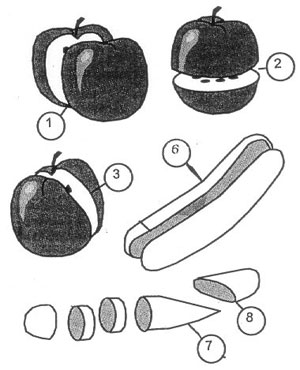

Fossils are the remains of ancient life. Often, fossils represent only part of the ancient organism, usually the hard parts. To complicate matters, only some of the hard parts may be exposed along a bedding surface, making it difficult to determine the true shape of the fossil, let alone the organism the fossil represents. In this activity, you will see the effect cutting recognizable objects has on your ability to identify them. It is a lesson in perspective, geometry, and fossils all in one.
Discovery: Look at the fossils in the floor of the William T. Young Library (or other cut stones containing fossils). This can be done during an actual visit, or you can take a virtual trip . How many different shapes can you see? Some are different types of fossils. Many, however, belong to one type of fossil. Many of the circular, U-, and V-shaped fossils represent two-dimensional slices through the same type of fossils. Can you imagine what type of shape the fossil might have in three dimensions? That will help you determine what the fossil is. Try to draw what you imagine the organisms looked like when they were alive, then do the extension activity.
Materials: Four apples, four bananas (peeled), cutting board, and knife for cutting fruitSafety: Using a knife poses the risk of a cut or puncture wound. Handle any sharp object with extreme care. Always cut away from your body. Children should let teachers or parents cut the fruit.
Goal: To show that it can be difficult to determine the three-dimensional appearance of an object from two-dimensional slices through the object.
Procedure:
|
 |
Follow-up: Pick up a copy of the fact sheet, Fossils at the William T. Young Library , to see the true shapes of the ancient animals whose remains are preserved as fossils in the limestone.
Connections to Kentucky Program of Studies and Core Content for Assessment
Grades Primary–4—Earth/Space Science: Properties of earth materials. Grades 5–7—Life science: Diversity and adaptions of organisms, also Earth/Space Science: Earth's history. Grade 8—Earth/Space Science. Grades 9–12—Earth/Space Science: The formation and ongoing changes of the earth system, also Life Science: Biological change.
Handout by Stephen F. Greb 1 , Kathy Trundle 2 , and Donald R. Chesnut, Jr. 1 , 1 Kentucky Geological Survey, 2 Kentucky Department of Education, University of Kentucky. Created in 1999. Modified and posted to the Internet in 2005.
Fact sheet link is http://www.uky.edu/KGS/education/YoungFossils-11.pdf
Back to Earth Science Classroom Activities